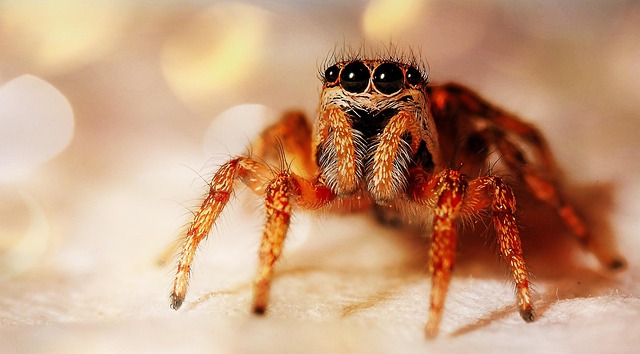Understanding spider behavior (nocturnal/diurnal, food sources, habitat preferences) is key to effective spider prevention. This involves sealing entry points, maintaining cleanliness, and targeting strategies based on species and time of day. A customized plan, including regular inspections, natural repellents, and seasonal adjustments, ensures long-term protection from spiders. Consistent maintenance and proactive measures like cleaning and sealing gaps are crucial for a pest-free environment.
In many parts of the world, spiders can be a significant indoor and outdoor nuisance. To achieve long-term protection, understanding these arachnids is key. This article guides you through crafting a personalized spider prevention plan. We’ll explore spider behavior, common species, and their preferences, enabling you to develop an effective strategy. Learn essential tips for implementation and maintenance to keep spiders at bay, ensuring a comfortable living or working environment. Discover the best practices for comprehensive spider prevention today.
Understanding Spider Behavior and Habitat
Understanding Spider Behavior and Habitat is a crucial step in implementing effective spider prevention tips for long-term protection. Spiders are arachnids with intricate web-spinning abilities, often seeking shelter in dark, secluded areas like cracks, crevices, and corners. They are attracted to food sources, especially insects, and will enter homes or buildings if these are present. Knowing their preferred habitats allows for targeted prevention measures, such as sealing entry points and maintaining a clean environment.
Spiders also have distinct behaviors that can help in devising a customized spider prevention plan. Many species are nocturnal, preferring to hunt at night, while others are diurnal and active during the day. Understanding these patterns helps in identifying when and where to focus your efforts, whether it’s sealing windows and doors at night or maintaining a regular clean-up routine during the day. By combining knowledge of spider habits with strategic prevention tips, you can create an environment that discourages spiders from entering and staying.
Identifying Common Spider Species and Their Preferences
Understanding the behavior and preferences of common spider species is a crucial step in developing effective spider prevention strategies for long-term protection. Different spiders have distinct habits and habitats, which can vary based on their size, diet, and nesting requirements. For instance, house spiders tend to seek shelter in dark corners and cracks, often found near sources of food like insects or pet food. On the other hand, black widows prefer secluded areas with minimal disturbances and are known for their aggressive defense mechanism. Identifying these preferences allows homeowners and professionals to implement targeted spider prevention tips, such as sealing entry points, maintaining cleanliness, and using specific treatments tailored to each species.
By recognizing the unique characteristics of various spiders, you can create a comprehensive plan that addresses their specific needs and habitats. This proactive approach ensures that your spider prevention efforts are not only effective but also sustainable over time. Regular inspections and seasonal adjustments in your prevention strategy will further enhance the protection against these eight-legged intruders, providing peace of mind for any homeowner concerned about long-term spider control.
Developing a Comprehensive Customized Spider Prevention Plan
Developing a comprehensive customized spider prevention plan is essential for long-term protection. It begins with identifying specific spider species prevalent in your region and understanding their behavior, preferences, and entry points into structures. This knowledge allows for targeted strategies that cater to each species’ unique traits. For instance, sealing gaps around windows and doors, installing mechanical traps, or applying strategic treatments with minimal environmental impact.
Implementing these spider prevention tips involves a multi-faceted approach. Regular inspections help identify potential entry points, while maintaining a clean and clutter-free environment reduces hiding spots. Using natural repellents like citrus oils or mint can also deter spiders without harming pets or humans. Combining these methods creates an effective barrier against spiders, ensuring your space remains pest-free over time.
Long-term Implementation and Maintenance Strategies for Effective Spider Control
Implementing a customized spider prevention plan is just the first step; long-term success hinges on consistent maintenance and proactive strategies. Regular inspections are crucial to identify any new entry points or signs of infestation, allowing for immediate action. Seasonal changes often bring shifts in spider behavior, so adapting your control methods accordingly is essential. For example, sealing gaps during the warmer months when spiders actively seek new habitats can significantly reduce re-infestation risks.
Additionally, staying vigilant and proactive with spider prevention tips like keeping areas clean, especially in hard-to-reach corners, and storing items off the ground, provides an environment less welcoming to these arachnids. Regular maintenance ensures that your home remains a hostile territory for spiders, promoting long-term protection and peace of mind.
Implementing a customized spider prevention plan, tailored to understanding local species’ behaviors and preferences, is key to achieving long-term protection. By combining environmental adjustments, regular maintenance, and targeted treatments, homeowners can create an environment that discourages spiders from invading their spaces. Adhering to these spider prevention tips ensures a safe, spider-free home for years to come.
